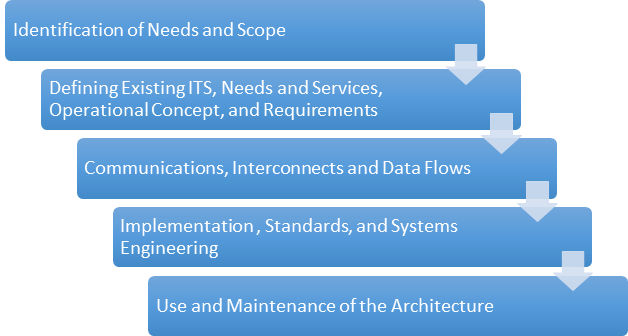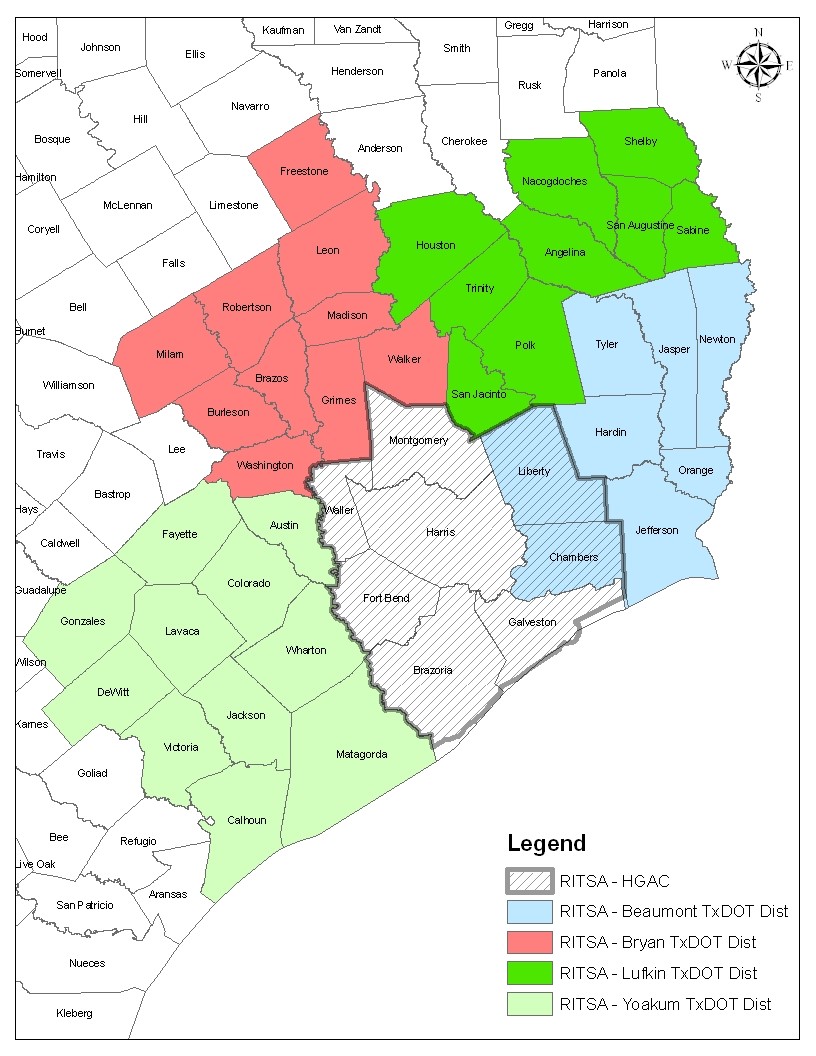In order to provide the framework to address the five themes of the National ITS Strategic Plan in the Houston-Galveston region, the Regional ITS Architecture provides a foundation for an ITS deployment plan that spans all organizations and individual transportation projects. Using the architecture, each transportation project can be viewed as an element of the overall transportation system, providing visibility into the relationship between individual transportation projects and ways to cost-effectively build an integrated transportation system over time:
- It is based on function.
- It does not seek to specify an equipment or technology standard.
- It defines what is to be done, not how, since technology is likely to outpace any attempt to lock-in any particular vendor or product specification.
- It specifies how data is to flow between systems, and suggests standards that can be used for the transfer of data.
There are two basic parts of the RITSA itself: subsystems and information flows.
- Subsystems are parts of ITS which perform particular functions (manage traffic, provide traveler information, etc.) that are often associated with individual agencies or organizations (departments of transportation, public safety agencies, or information providers). These are the things that ITS does.
- Information flows define pieces of data that are exchanged between subsystems (sensor data, incident information, traffic signal control data, etc.). These are the data that ITS systems generate and send to be used by systems, agencies, and end users, including travelers.
In the RITSA, information flows show how ITS systems are integrated by showing the links between subsystems. This integration is technical and institutional, as the system interfaces require cooperation on the part of the owners of the individual subsystems.
Traditionally, a paper document documenting the ITS Architecture is produced that is then periodically updated. In order to maintain a current and up-to-date RITSA, HGAC has transitioned this document to a web format with an aim to a maintain a “living” RITSA. This “living” document concept will help the region maintain information and not require large periodic efforts, saving time and money.
How Can the Living RITSA Help You?
The ITS architecture defines the vision of ITS that stakeholders will seek for the region for the next five to ten years. It defines what types of strategies are a priority, and what types of projects funding parties should consider for deployment as funding, technology, and institutional agreement is achieved.
For transportation, public works, and transit implementing agencies...
The architecture provides a framework for the development of interoperable ITS systems that can share data based on regionally determined standards of data flows. The architecture document is the starting place for developing individual project concept of operations and requirements, and can provide guidance on the use of the systems engineering process through design and testing of ITS projects.
For planners...
The architecture guidance can provide a basis for the inclusion of projects into the Long-Range Transportation Plan (LRP) and Transportation Improvement Program (TIP). It can provide input into corridor and sub-regional studies, congestion monitoring activity, and other plans and studies.
For first responder agencies...
The architecture guidance can provide insight on the data flows that may be shared between police, fire, and emergency medical services and transportation agencies to best coordinate incident and emergency management. It can also highlight opportunities that may exist (or be found) to enhance security and response capabilities.
For businesses...
The architecture can help identify opportunities for research and development, and gauge the regions short and long-term planning process to anticipate local agency needs for equipment and technology.
For travelers...
The architecture shows what types of services that government and the private sector may provide using intelligent transportation systems, and what types of capabilities travelers can expect in the near future.
The website presents an operational concept for ITS in the region and discusses the high-level functional requirements necessary for ITS systems to meet. Interconnects and systems interfaces are defined and agency agreements and standards are identified. Project sequencing is addressed at a high level, and how to use and maintain the architecture is presented.
Developing Regional ITS Guidance
HGAC developed this regional ITS guidance with input from many stakeholders and participating agencies. The bulk of the information was captured from past RITSA efforts that consisted of documenting the needs for ITS in the region and gathering input from the stakeholders tasked with the responsibility to deploy, operate and maintain ITS.
This guidance presents an operational concept for ITS in the region and discusses the high-level functional requirements necessary for ITS systems to meet. Interconnects and systems interfaces are defined and agency agreements and standards are identified. Project sequencing is addressed at a high level, and how to use and maintain the architecture is presented.
Methododolgy for Developing this Guidance
The overall development of the regional ITS architecture and corresponding generally followed the process shown in the figure below. These general descriptions are followed up in subsequent sections in more detail, each of which summarizes a significant step in the architecture/guidance development. The development of the regional ITS architecture and the additional ITS guidance is being completed in the context of the regional project planning and development process.

The preparation of this guidance began with updated surveys of transportation agencies and leveraged past effort including a survey of first responders in the area. A discussion of those needs, a regional concept of operations for ITS, the use of standards, and high-level functional requirements for ITS are included in this updated guidance.
Systems Engineering
A key aspect of this architecture guidance is a discussion of the systems engineering process, when it should be used in more detail, and what it should entail for various types of projects. This discussion was utilized to develop the region’s first Risk-Based Systems Engineering Process which is a key feature of this website and can be downloaded by clicking the button below.
Turbo Architecture File
The Requirement to Use a Regional ITS Architecture
The RITSA requirement has its roots in the Transportation Equity Act for the 21st Century (TEA-21, 1998). The highlights of compliance with Federal regulations are:
- TEA-21 (1997)
- USDOT/FHWA published FHWA Rule 940 (https://ops.fhwa.dot.gov/its_arch_imp/policy_1.htm#940_5) (as part of 23 CFR 940, 2001)
- FTA published a Policy to implement section 5206(e) of TEA-21 in 2001.
- This Final Rule/Policy encourages regional integration by requiring all Highway Trust Fund ITS projects conform to the National ITS Architecture and associated standards.
- A region is in conformance with the National ITS Architecture by developing a regional ITS architecture tailored to local needs, with all Federally funded ITS projects then being compliant with the regional ITS architecture.
- SAFETEA-LU (2003) retained the Final Rule/Policy and included new provisions in Section 1201.c requiring State and local governments to address real-time highway and transit information when developing or updating regional ITS architectures.
- ITS data is important to the region because Section 6001 of SAFETEA-LU mandated that the Houston-Galveston region establish a congestion management process (CMP).
- The CMP should make use of archived ITS data where possible.
- Every effort should be made to leverage ITS deployments in support of the CMP data collection effort.
- Moving Ahead for Progress in the 21st Century Act (2012)
- FAST Act (2016) Fixing America’s Surface Transportation Act (FAST Act § 6002, 6005-6010; 23 U.S.C. 512-519) continues the ITS program which provides research, development and operational testing of ITS. This continuation is guided by a five-year strategic plan.
But to incorporate ITS into the transportation network, it must be injected into the transportation planning and project development process that exists in the region. In 2001, FHWA and FTA published the rules that address the inclusion of ITS in regional planning activities and how projects should be delivered so that they lead to integrated systems, and Federal funding relies on compliance with these rules.
Scope of the Regional ITS Architecture
The Houston-Galveston Regional ITS Architecture covers the following eight Texas Counties:
- Brazoria
- Chambers
- Fort Bend
- Galveston
- Harris
- Liberty
- Montgomery
- Waller
TxDOT has undertaken a comprehensive effort to develop regional ITS architectures for many TxDOT districts where the MPO has not completed the RITSA. TxDOT has developed regional ITS architectures for the Brazos Valley, Lufkin, Beaumont, and Yoakum regions.
The map below shows the HGAC region in relation to the four bordering regions, which have standalone ITS architectures:
- Brazos Valley (Bryan, to the northwest), dated April 2004
- Lufkin (to the northeast), dated June 2005
- Beaumont (to the east), dated December 2003
- Yoakum (to the west), dated July 2005
The Houston-Galveston Regional ITS Architecture includes the TxDOT Houston District and two counties within the TxDOT Beaumont District, but which are also in the HGAC service area (Chambers and Liberty counties). During ITS project development, agencies with jurisdiction in Chambers and Liberty counties should seek guidance from both the HGAC RITSA as well as the Beaumont RITSA. Beaumont’s RITSA also includes the city of Baytown, Texas, since Baytown has city limits in both Chambers and Harris counties. Baytown will also be included in the HGAC RITSA.

Timeframe of the RITSA
Most architectures are developed for a time horizon of 15-20 years and incorporate existing and planned ITS capability. However, this living document presents ITS development in near- and medium-term timeframes, with the anticipated ITS projects captured within the architecture over future years.
Users should understand that minor changes to the architecture could occur several times per year. Users can find the latest versions of the architecture RAD-IT file here, along with guidance on the changes made since the architecture was initially prepared. This is especially important when preparing project architectures or planning for future project architectures.
However, the proposed ITS deployment plan has two elements:
- A near-term deployment plan (one to five years) which identifies the ITS systems that should have the highest priority based on the stated needs of the stakeholders. It should be noted that there could be many factors impact the timing of particular project implementation (availability of funding, compatibility with other regional and/or local projects, and coordination with roadway construction projects). At this time, the near-term deployment of ITS concentrates on the continued development of the data collection and data processing systems for the region, especially in continued development of systems on freeways and tollways, but also moving to the regionally significant arterials. However, an increasing priority is on equipping transit with ITS systems to enable corridor management capability.
- A more general, medium-term deployment plan (six to ten years) is also presented that builds on existing and near-term priorities. The medium-term deployment emphasizes the connection of sub-regional transportation and emergency management centers (e.g., city and county centers), development of advanced ITS software systems for the purposes of providing more automated and cooperative operations of the systems.
The strategic part of this plan/guidance examines long-term development (10+ years), but recognizes that discussion of ITS systems in a long-term light is more conceptual than concrete. In a developing a longer-term view of ITS systems, projects that may eventually be considered for implementation are currently in the research and/or development phases. Future systems include those involving advanced vehicle safety, vehicle-roadside communications, and automated vehicle and security operations.
It is recommended that the Operations Task Force at HGAC continue to monitor trends and developments in ITS to harness evolving and enabling technologies as they become viable. As this plan and future guidance is updated, local stakeholders should conduct periodic reviews of ITS deployment and determine if there are significant changes in technologies that require the RITSA and deployment plans to be revised. Revisions can be suggested through the Change Management Process.
 Houston-Galveston Area Council Transportation Systems Management & Operations Clearinghouse
Houston-Galveston Area Council Transportation Systems Management & Operations Clearinghouse
 Houston-Galveston Area Council Transportation Systems Management & Operations Clearinghouse
Houston-Galveston Area Council Transportation Systems Management & Operations Clearinghouse

